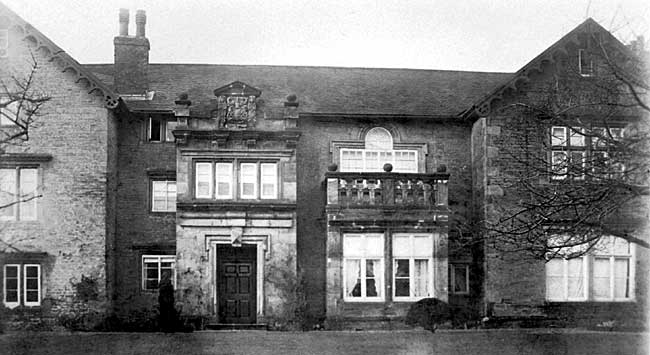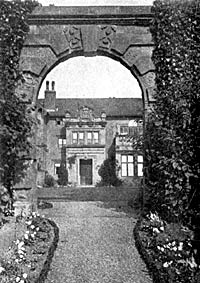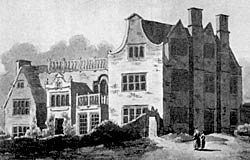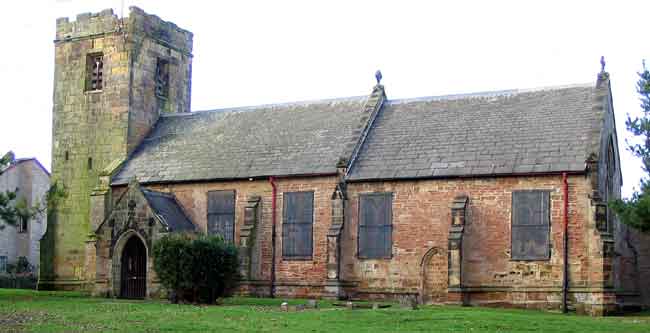Broxtowe Hall and Bilborough

Broxtowe Hall in the 1920s.
 Broxtowe Hall.
Broxtowe Hall.Turning abruptly to the right at Cinder Hill the party soon reached Broxtowe Hall, now only a remnant, but still bearing traces of its former state, in mullioned windows and obliterated armorial bearings. Before the Conquest, Broxtowe belonged to Earl Godric. Its former importance is shown by the fact that it was the meeting place of the Broxtowe Hundred. In later times the old hall was occupied by Sir Hugh Willoughby, the famous Arctic navigator. The property is now owned by Lord Middleton.
In the reign of Charles I. Thomas Smith, son of Sir Francis Smith, of Ashby Folviile, purchased the estates and rebuilt the Hall. During the Civil War it was occupied by a small garrison, and for this service the owner received the honour of knighthood from the king.
In 1643, intelligence having been received that the Cavaliers intended to possess themselves of Broxtowe and Wollaton halls, near the town of Nottingham, Captain Palmer, with a small body of Parliamentarian troops, was sent to occupy Broxtowe, whilst another officer from the Castle was dispatched with a company to Wollaton.

Broxtowe Hall in 1833.
The Hall sustained considerable damage during the war, and was afterwards bought by William Cavendish, the first Earl of Newcastle, for Sir Francis Top, who had been his companion through the whole of the wars, and whose lady, Elizabeth Chaplain, had been servant to the Duchess of Newcastle from her childhood. The present hall is but a remnant of the Caroline building, and is now used as a farmhouse. The garden entrance fell about 30 years ago, owing to subsidence caused by working the coal, but it has been rebuilt stone for stone, minus the pediment shewn in an old engraving, dated 1700, and the wing on the north side is shown three stories in height even as late as 1835.
There must have been a church at Broxtowe at one time, but all traces of it are now lost. In all probability it stood on the ground on the north side of the hall. There are indications of foundations beneath the turf, and bones and skulls have been exhumed from time to time when digging for farm purposes. The following is an extract from the Torre MS.—“Broxtowe church was an ancient rectory, belonging to the Priory of Sempringham till the 26th April, 1458, when, upon the petition of Robert Strelley, Esq., it was united to the Church of Bilbrough,” it having been found that there were not 10 inhabitants who were housekeepers. The list of rectors extends from 1281 to 1468.

St Martin's church, Bilborough, dates from the 14th and 15th centuries (photo: A Nicholson, 2009).
Midway between Broxtowe and Strelley lies the little hamlet of Bilborough. Although the party had not time to stop, it should not be passed by without a reference. It stands beside the old “Pilgrim path” leading to Dale Abbey. At one time this was a narrow pack-horse road, paved with slabs of local stone, leading straight from Trent Bridge, up through the town, across the Lammas fields, by Aspley, Strelley, Cossall, and on into Derbyshire. The old stone paving has just been removed at Strelley, during the operation of laying in a new water service, but fragments still remain between Strelley and Cossall. At the junction of Broxtowe lane and Strelley road, the old coal wharf for Nottingham once stood; the buildings now called Machine Cottages, were the weighing machine and other offices, and the track of the tram line is still clearly seen in the adjoining fields. A little further on the old “tythe barne of Billbrow” forms a conspicuous object. It has lately been put into good repair. The “columbarium” was added at a later date, but the main walls are the original work. The church stands a little way back from the road, and is now dedicated to St. Martin, although the earliest references (1291) are to St. Cuthbert. The plan consists of nave (without aisles), chancel and western tower, porch and entrance on the south side, and there is also a good doorway on the north side built up with masonry. The cills of the windows at the west end of the nave are high up to suit the level of the “commodious singers’ gallery” that once existed here. This was cleared away during the restorations made by the late squire, James T. Edge, in 1877, when the lath and plaster ceiling over the chancel was replaced with an open timber roof of oak, the walls cleaned of whitewash and re-plastered, and a vestry added on the north side. The details of the old portion of the church correspond with the work at Nuthall—the two churches were apparently built at about the same time and by the same craftsmen. The only monument of interest is to Edmund Helwys, buried 24th October, 1590. He wished to be buried “in the chancel, or near the pue door, with arms showing his marriage above.” The tomb was shifted from its place during alterations to the church in 1833, and eventually broken up, only the marble tablet remains fixed on the north wall of the chancel. It contains a shield bearing a fesse over all a bend. Then follows an inscription in Latin verse, very much defaced and difficult to decipher, lamenting the decease of father and daughter at the same time, as follows
EDMUNDE EXIGUO RESIDENS HELWISE SEPULCHRO
EXTREMUM DOCEAS CORPORIS OMNIS ITER.
NATA SIMUL DILECTA TIBI VI MORTIS INIQUAE
RAPTA SUB HOC TUMULO CUM GENITORE JACET.
SCILICET HIC MORTIS MOS EST MORTISQUE TRIUMPHUS
GRANDAEVOS TENERIS TOLLERE SAEPE SIMUL.
AETAS5 FLOS SERUS NON RUMPUNT VINCULA MORTIS
NATA PATERQUE CADUNT TEMPORE NATA PRIOR.
The registers go back to 1569, and contain some very interesting notes and memoranda, viz :—A copy of the above inscription from the Helwys tomb, written in by “William Gooday, Rector of Bilborow Church, June, 1776.”
“In 7 Henry VI. an inquest was held in Nottingham, John de Broxtow being foreman of the Jury, to inquire into the number of householders in the parish of Broxtow.” The result was that in 1458 the Church (Broxtow) was united to the Church of Bilborough.
In 1513 Dame Agnes Mellors founded a Grammar school in Nottingham and John Smith, Parson of Bilboro, was appointed to be the first master.
